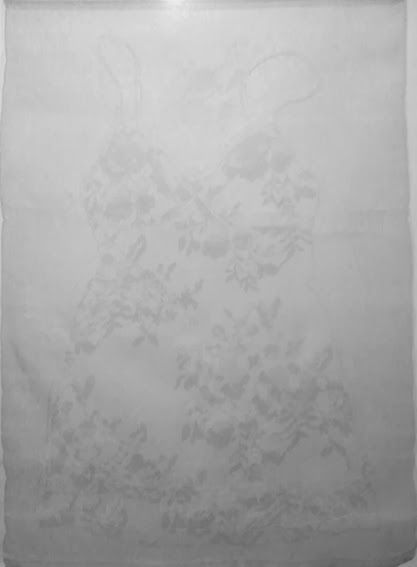Yesterday I broke from my usual blogging and office work routine to head into the city (Toronto) - 75 km from where I live - to meet up with a friend, have lunch and then some exhibitions that included woven items. Before I share that with you, a reminder that it is not too late to see Nieves Carresco's exhibition at the David Kaye Gallery (http://www.davidkayegallery.com/). Nieves, architect by training with a textile background, has created beautifully and intricately woven fine strips of washi paper that she has painted on with ink (image shown above).
Imperial Floods, assorted synthetic and natural fibres. Tim Manalo.
Our first stop was the Gladstone Hotel on Queen St West (http://www.gladstonehotel.com/, where we viewed the exhibition Hardtwist. You'll have to go to the third and fourth floors to see this interesting and thought provoking exhibition.Since there is so much available in terms of promoting other textile arts and crafts, I focused only on presenting what incorporated weaving.
Safe Keeping (Five Journals 1993-2013. Amy Bagshaw.
Some people of a certain generation and training may not find many of these pieces aesthetically pleasing, perhaps its because it is not their raison d'etre. Instead the works presented gave one much food for thought and provoked discussion, sometimes heated.
Talking to Myself. woven woodcut print on paper. Ann Devitt. www.anndevitt.ca
Drawing/Weaving. Colleen McCarten. www.colleenmccarten.com.
The piece on the left is woven in tabby, the roll of parchment on the right, is a very detailed drawing of weaving structure. I wondered to myself, is it asking that weaving be considered with the same respect and reverence as art or even architectural drafting.
Marie Pierre Daigle. Mycelium. www.mpdaigle.com
"Mycelium is the vegetative part of a fungus, consisting of a mass of branching, thread-like hyphae. The mass of hyphae is sometimes called shiro, especially within the fairy ring fungi. Fungal colonies composed of mycelium are found in and on soil and many other substrates. A typical single spore germinates into a homokaryotic mycelium, which cannot reproduce sexually; when two compatible homokaryotic mycelia join and form a dikaryotic mycelium, that mycelium may form fruiting bodies such as mushrooms. A mycelium may be minute, forming a colony that is too small to see, or it may be extensive:
Is this the largest organism in the world? This 2,400-acre (9.7 km2) site in eastern Oregon had a contiguous growth of mycelium before logging roads cut through it.Estimated at 1,665 football fields in size and 2,200 years old, this one fungus has killed the forest above it several times over, and in so doing has built deeper soil layers that allow the growth of ever-larger stands of trees. Mushroom-forming forest fungi are unique in that their mycelial mats can achieve such massive proportions.
—Paul Stamets, Mycelium Running[1]
It is through the mycelium that a fungus absorbs nutrients from its environment. It does this in a two-stage process. First, the hyphae secrete enzymes onto or into the food source, which break down biological polymers into smaller units such as monomers. These monomers are then absorbed into the mycelium by facilitated diffusion and active transport.
Mycelium is vital in terrestrial and aquatic ecosystems for their role in the decomposition of plant material. They contribute to the organic fraction of soil, and their growth releases carbon dioxide back into the atmosphere. The mycelium of mycorrhizal fungi increases the efficiency of water and nutrient absorption of most plants and confers resistance to some plant pathogens. Mycelium is an important food source for many soil invertebrates.
One of the primary roles of fungi in an ecosystem is to decompose organic compounds. Petroleum products and pesticides, typical soil contaminants, are organic molecules, i.e. they are built on a carbon structure. This means that these substances present a potential carbon source for fungi. Hence, fungi have the potential to remove such pollutants from the soil environment, unless the chemicals prove toxic to the fungus. This biological degradation is a process known as bioremediation." Wikipedia
Joanna Schleimer. Slip. Hand woven silk.
This piece was very finely woven, like a transparency technique. Joanna placed the weaving about an inch or 2 away from the base from the frame, so that when the light shone on it, it created a secondary shadow effect in the background. An enchanting and highly skilled piece of weaving and art. Here is a link to her website where you will see more mesmerizing work. http://joannaschleimer.com/
detail of Slip by Joanna Schleimer
Our last stop was at the Ontario Craft Council gallery at 990 Queen Street West to see the hand & MACHINE exhibition. Here too they had some interesting objects that referenced weaving technically and incorporated contemporary technological weaving approaches. Hot Pop does digital 3d printing http://www.hotpopfactory.com/index.html. Here's a little more info about Ozana - http://www.slideshare.net/ozanagherman. In the image below, you can read in more detail about what this piece is about.
The Ontario Craft Council has a new website to reflect it's new image and mandate http://craftontario.com. You may want to join when you see how they will assist you in marketing your work.
Weaving exhibitions, resources, information
Ted Hallman, once a teacher at OCADU, (and one of my instructors) is having an exhibition in Pennsylvania. Click on this link http://mhep.org/exhibits/ then click on the Hallman Legacy.
Jenny Gilbert sends along this interesting link featuring weaving as art - both fabric and tapestry woven simple techniques. http://www.new-friends.us/
Inga Tomas sends this link along featuring her work: http://ingi.smugmug.com/WEAVING/n-JVbsp/i-QgWMkKd. She also highly recommends this book:
Marilyn Hotta has a 60" loom for sale. Go to this link to find out more: http://toronto.kijiji.ca/c-buy-and-sell-hobbies-crafts-Leclerc-60-Colonial-Loom-W0QQAdIdZ548194621











No comments:
Post a Comment
Note: Only a member of this blog may post a comment.